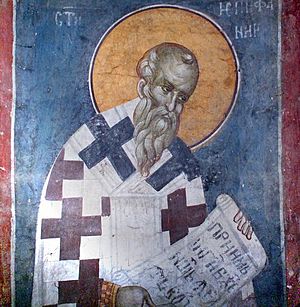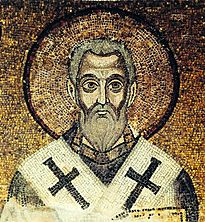Epiphanius of Salamis facts for kids
Quick facts for kids SaintEpiphanius of Salamis |
|
|---|---|

St. Epiphanius in a fresco painting (Gračanica Monastery)
|
|
| Bishop of Salamis (Cyprus), Oracle of Palestine | |
| Born | c. 310–320 Judea |
| Died | 403 (aged 82–93) at sea |
| Venerated in | Catholicism Eastern Orthodoxy Oriental Orthodoxy |
| Feast | 12 May 17 Pashons (Coptic Orthodoxy) |
| Attributes | Vested as a bishop in omophorion, sometimes holding a scroll |
| Controversy | Iconoclasm |
Epiphanius of Salamis (Greek: Ἐπιφάνιος; c. 310–320 – 403) was the bishop of Salamis, Cyprus, at the end of the 4th century. He is considered a saint and a Church Father by both the Eastern Orthodox and Catholic Churches. He gained a reputation as a strong defender of orthodoxy. He is best known for composing the Panarion, a compendium of eighty heresies, which included also pagan religions and philosophical systems. According to Ernst Kitzinger, he "seems to have been the first cleric to have taken up the matter of Christian religious images as a major issue", and there has been much controversy over how many of the quotations attributed to him by the Byzantine Iconoclasts were actually by him. Regardless of this he was clearly strongly against some contemporary uses of images in the church.
Life
Epiphanius was either born into a Romaniote Christian family or became a Christian in his youth. Either way, he was a Romaniote Jew who was born in the small settlement of Besanduk, near Eleutheropolis (modern-day Beit Guvrin in Israel), and lived as a monk in Egypt, where he was educated and came into contact with Valentinian groups. He returned to Roman Palestine around 333, when he was still a young man, and he founded a monastery at Ad nearby, which is often mentioned in the polemics of Jerome with Rufinus and John, Bishop of Jerusalem. He was ordained a priest, and lived and studied as superior of the monastery in Ad that he founded for thirty years and gained much skill and knowledge in that position. In that position he gained the ability to speak in several tongues, including Hebrew, Syriac, Egyptian, Greek, and Latin, and was called by Jerome on that account Pentaglossos ("Five tongued").
His reputation for learning prompted his nomination and consecration as Bishop of Salamis, Cyprus, in 365 or 367, a post which he held until his death. He was also the Metropolitan of the Church of Cyprus. He served as bishop for nearly forty years, as well as travelled widely to combat differing beliefs. He was present at a synod in Antioch (376) where the Trinitarian questions were debated against the heresy of Apollinarianism. He upheld the position of Bishop Paulinus, who had the support of Rome, over that of Meletius of Antioch, who was supported by the Eastern Churches. In 382 he was present at the Council of Rome, again upholding the cause of Paulinus.
The curtain incident
Letter LI in Jerome's letters gives Jerome's Latin translation, made at Epiphanius' request, of his letter, originally in Greek from c. 394, "From Epiphanius, Bishop of Salamis, in Cyprus, to John, Bishop of Jerusalem" (see previous section for wider context).
Writings
Panarion
His best-known book is the Panarion (from Latin panarium, "bread basket" < panis, "bread"), also known as Adversus Haereses, "Against Heresies", presented as a book of antidotes for those bitten by the serpent of heresy. Written between 374 and 377, it forms a handbook for dealing with the arguments of heretics.
It lists, and refutes, 80 heresies, some of which are not described in any other surviving documents from the time. Epiphanius begins with the 'four mothers' of pre-Christian heresy – 'barbarism', 'Scythism', 'Hellenism' and 'Judaism' – and then addresses the 16 pre-Christian heresies that have flowed from them: four philosophical schools (Stoics, Platonists, Pythagoreans and Epicureans), and 12 Jewish sects. There then follows an interlude, telling of the Incarnation of the Word. After this, Epiphanius embarks on his account of the 60 Christian heresies, from assorted gnostics to the various trinitarian heresies of the fourth century, closing with the Collyridians and Messalians.
While Epiphanius often let his zeal come before facts – he admits on one occasion that he writes against the Origenists-based only on hearsay (Panarion, Epiphanius 71) – the Panarion is a valuable source of information on the Christian Church of the fourth century. It is also an important source regarding the early Jewish gospels such as the Gospel according to the Hebrews circulating among the Ebionites and the Nazarenes, as well as the followers of Cerinthus and Merinthus.
One unique feature of the Panarion is in the way that Epiphanius compares the various heretics to different poisonous beasts, going so far as to describe in detail the animal's characteristics, how it produces its poison, and how to protect oneself from the animal's bite or poison. For example, he describes his enemy Origen as "a toad noisy from too much moisture which keeps croaking louder and louder." He compares the Gnostics to a particularly dreaded snake "with no fangs." The Ebionites, a Christian sect that followed Jewish law, were described by Epiphanius as "a monstrosity with many shapes, who practically formed the snake-like shape of the mythical many-headed Hydra in himself." In all, Epiphanius describes fifty animals, usually one per sect.
Another feature of the Panarion is the access its earlier sections provide to lost works, notably Justin Martyr's work on heresies, the Greek of Irenaeus' Against Heresies, and Hippolytus' Syntagma. The Panarion was first translated into English in 1987 and 1990.
Other works
His earliest known work is the Ancoratus (the well anchored man), which includes arguments against Arianism and the teachings of Origen. Aside from the polemics by which he is known, Epiphanius wrote a work of biblical antiquarianism, called, for one of its sections, On Weights and Measures (περὶ μέτρων καὶ στάθμων). It was composed in Constantinople for a Persian priest, in 392, and survives in Syriac, Armenian, and Georgian translations (this last is found in Shatberd ms 1141 along with Physiologus and De Gemmis). The first section discusses the canon of the Old Testament and its versions, the second of measures and weights, and the third, the geography of Palestine. The texts appear not to have been given a polish but consist of rough notes and sketches, as Allen A. Shaw, a modern commentator, concluded; nevertheless Epiphanius' work on metrology was important in the history of measurement.
Another work, On the Twelve Gems (De Gemmis), survives in a number of fragments, the most complete of which is the Georgian. The letter written by Epiphanius to John, Bishop of Jerusalem, in 394 and preserved in Jerome's translation, is discussed above. The collection of homilies traditionally ascribed to a "Saint Epiphanius, bishop" are dated in the late fifth or sixth century and are not connected with Epiphanius of Salamis by modern scholars.
Such was Epiphanius's reputation for learning that the Physiologus, the principal source of medieval bestiaries, came to be widely falsely attributed to him.
Works
- The Panarion of Epiphanius of Salamis, Book I (Sects 1–46) Frank Williams, translator, 1987 (E.J. Brill, Leiden) ISBN: 90-04-07926-2
- The Panarion of Epiphanius of Salamis, Book II and III (Sects 47–80, De Fide) Frank Williams, translator, 1993 (E.J. Brill, Leiden) ISBN: 90-04-09898-4
- The Panarion of St. Epiphanius, Bishop of Salamis Philip R. Amidon, translator, 1990 (Oxford University Press, New York) (This translation contains selections rather than the full work.) ISBN: 0-19-506291-4
- Epiphanius' Treatise on Weights and Measures: The Syriac Version, James Elmer Dean, ed, 1935. (Chicago) [English translation of On Weights and Measures; available at Epiphanius of Salamis, Weights and Measures (1935) pp.11-83. English translation]
- Epiphanius de Gemmis: the Old Georgian Version and the Fragments of the Armenian Version. ed. Robert Pierpont Blake; de Vis, H. (1934). London: Christophers.
- Epiphanius von Salamis, Über die zwölf Steine im hohepriesterlichen Brustschild (De duodecim gemmis rationalis). Nach dem Codex Vaticanus Borgianus Armenus 31 herausgegeben und übersetzt by Felix Albrecht and Arthur Manukyan (Gorgias Eastern Christian Studies 37), 2014 (Gorgias Press: Piscataway) ISBN: 978-1-4632-0279-8 (German edition).
- Anacephalaiosis (originally thought to be the work of Epihanius of Salamis, although this opinion is now disputed).
See also
 In Spanish: Epifanio de Salamina para niños
In Spanish: Epifanio de Salamina para niños


